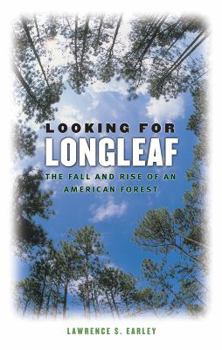Looking for Longleaf: The Fall and Rise of an American Forest
Select Format
Select Condition 
Book Overview
Covering 92 million acres from Virginia to Texas, the longleaf pine ecosystem was, in its prime, one of the most extensive and biologically diverse ecosystems in North America. Today these magnificent... This description may be from another edition of this product.
Format:Paperback
Language:English
ISBN:0807856991
ISBN13:9780807856994
Release Date:September 2004
Publisher:University of North Carolina Press
Length:336 Pages
Weight:1.15 lbs.
Dimensions:0.8" x 6.1" x 9.2"
Customer Reviews
5 ratings
North America's Most Important Tree
Published by Thriftbooks.com User , 14 years ago
Larry Early has composed a classic. If one tree species was selected as having the greatest impact on the history and development of the United States, it would be the longleaf pine. Most of the early European (English, Spanish, & French) settlements occurred in the native longleaf pine range which runs from Southeast Virginia to eastern Texas, covering an estimated 90-92 million acres. Before the first Europeans arrived, it is almost certain that millions of Native Americans lived and prospered among the longleaf pines, before foreign diseases decimated their ranks. For centuries, the naval stores production and export was one of the largest industries in North America. My mother's house in Marceline, Missouri was built of longleaf in the 1800's, brought in by rail. The Sears & Roebuck Warehouse in Chicago was once the largest wooden building in North America, and it was built of longleaf. The longleaf pine ecosystem is one of the most diverse ecosystems in the entire world. Many of our North America's Threatened and Endangered species are endemic to the fire-maintained longleaf pine forests of the Southeast. But by and large, few adults, and even fewer of the children in America even know what a longleaf pine is. Larry Early tells the story of the longleaf pine forests of North America, and he tells it well. I have spent much of my time as student, and my entire career (14 years) working to restore the longleaf pine forests of the Southeast. After centuries of declining acreage, longleaf has finally turned the corner, and today (2009), approximately 75 million longleaf pine are planted annually. Larry Early tells the story of the decline, and the renaissance of longleaf pine. If I could recommend one book for adults who are interested in learning more about longleaf pine, it would be "Looking for Longleaf" by Larry Early. And, as soon as you finish "Looking for Longleaf," get Janisse Ray's "Ecology of a Cracker Childhood." And if you know a young adult or middle school aged student, buy them "Longleaf" by Roger Reid. And if you ever find a copy of the 1946 monograph "Longleaf pine: Its use, ecology, regeneration, protection, growth, and management," by Wahlenberg, buy it and send it to me at the Solon Dixon Center in Andalusia, Alabama, because it is a tough book to find.
Superb book on several fronts...
Published by Thriftbooks.com User , 16 years ago
Earley was trying to write a history of turpentining. What he ended up with was a spectacular essay on the natural history of longleaf pine forests, the human history of the forested south, an essay on conflicting views in forestry, and....oh yes...turpentine! Reading this as an ecologist, I found everything I wanted with just enough of the human element to flesh it out without boring me. Oddly enough, I suspect those reading this from an anthropological view have the same opinion about the natural history aspect of the book. Earley is that good in weaving his tale. It flows well, is well organized, and the research and references are stunning. Twenty-three pages of references make me wonder how he ever finished the book. (In his acknowledgements he seems to wonder the same thing himself!) This book belongs on the shelf of every forester, ecologist, and southern historian. I'm just thankful I stumbled across it on a rainy day in Congaree National Park.
complete book about longleaf pines
Published by Thriftbooks.com User , 17 years ago
mr. earley goes deep into everything you could want to know about this native tree species,a cornerstone to both the natural world of the southeastern united states and the economic growth and development of the country as a whole.......he tells all about the past history,present day status,and projected outlook of the longleaf pine tree:it's one-time dominance of the coastal plain landscape,compared to it's present day status;all about the naval stores and timber industries,and their heavy dependence upon it that led to it's near demise and current numbers;and the changes in land management of the longleaf forest and it's various ecosystems,with much insight to the controlled burning philosophy that has gained in popularity during the last 50 years or so.....with photos, including some impressive shots of long-gone virgin growth trees dwarfing the grown men standing among them.
Best book on longleaf yet.
Published by Thriftbooks.com User , 18 years ago
This book is as accurate and detailed as any scholarly paper but is written so well that it is certain to be a classic of literature like Archie Carr's "The Windward Road."
America's Rain Forest
Published by Thriftbooks.com User , 19 years ago
For years I have been concerned about the disappearance of the South American Rain Forest. What was shocking from Earley's book is how we had our own expansive Forest with it's own ecosystem and let it disappear before our very eyes without anyone noticing. It is not only a wonderfully told story of the Longleaf pine but it is a genuine history of how the South's economic development between the time of the settlers and up until today nearly destroyed it's most valuable resource and the ecology that was a part of it. The only problem with this book was not being able to put it down after I started reading it.




